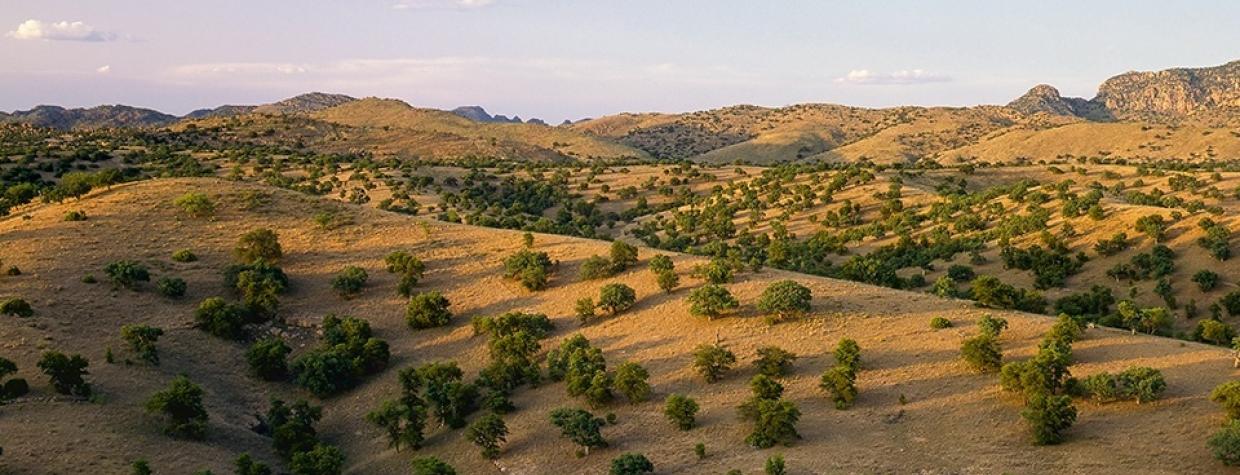Coronado National Forest, Nogales
If you’ve never driven down Interstate 19, which runs from Tucson to Nogales, you might not know that the distances on signs along that highway are in kilometers, rather than miles. You also might not know the highway passes some rugged and visually striking terrain. Ruby Road, which runs for 35 miles (that’s 56 kilometers) from I-19 to Arivaca, is a prime example.
This drive begins 56 miles south of Tucson. As you head west on the paved portion of Ruby Road, you’ll first encounter sparse settlements and the rolling foothills of the Pajarito Mountains. After 10 miles, you’ll reach a “T” junction. To the right is Peña Blanca Lake, created by a dam in 1957. The small lake is a popular fishing and boating location, and it also features several picnic areas. It’s worth a stop, especially this time of year. After that, go left at the junction to continue on Ruby Road.
At this point, the road runs out of pavement. The road conditions vary over the next 20 miles, but there are several rough patches, which means a high-clearance vehicle is a must. Ruby Road winds along the southern slopes of the Atascosa Mountains, offering expansive views of the Pajarita Wilderness to the south. This 7,500-acre wilderness is a haven for botanists: More than 600 plant species live there, and a few are found nowhere else on Earth. Make a few stops to take in the sights — the narrow road lacks guardrails and includes several sheer drop-offs, so it’s best not to admire the view with your foot on the gas pedal.
Jagged rock formations, ocotillo-covered hillsides and the occasional turkey vulture define the scenery as you continue. Around Mile 25, you’ll reach the ghost town for which Ruby Road is named. Ruby started as a mining claim, and at one time, the nearby Montana Mine was Arizona’s leading producer of lead and zinc. But the mine petered out in 1940, and the town went with it. Today, Ruby is one of Arizona’s best-preserved ghost towns, but as of 2024, it's no longer open to the public.
Five miles past Ruby, you’ll leave Santa Cruz County and enter Pima County. Here, the pavement begins again, and on a clear day, you’ll see the unmistakable profile of Baboquivari Peak to the northwest. After another 6 miles on Ruby Road, you’ll find yourself in Arivaca, an unincorporated community with shopping, dining and lodging options.
From Arivaca, your options are many. If you head northwest on Arivaca-Sasabe Road, you’ll enter Buenos Aires National Wildlife Refuge. If you’re ready to return to Tucson, follow Arivaca Road northeast to I-19 near Amado. Or you could just relax with a cold 12-ounce Coke at La Gitana Cantina. Twelve ounces is 355 milliliters, by the way.
Note: Mileages are approximate.
Length: 35 miles one way
Directions: From Tucson, go south on Interstate 19 for 56 miles to Ruby Road (Exit 12). Turn right onto Ruby Road (State Route 289) and continue 10 miles to a “T” junction. Turn left at the junction to stay on Ruby Road (now Forest Road 39) and continue 25 miles to Arivaca.
Vehicle requirements: A high-clearance vehicle is required. Four-wheel-drive is recommended but not necessary in good weather.
Warning: Back-road travel can be hazardous, so be aware of weather and road conditions. Carry plenty of water. Don’t travel alone, and let someone know where you are going and when you plan to return.
Information: Nogales Ranger District, 520-281-2296 or www.fs.usda.gov/coronado

